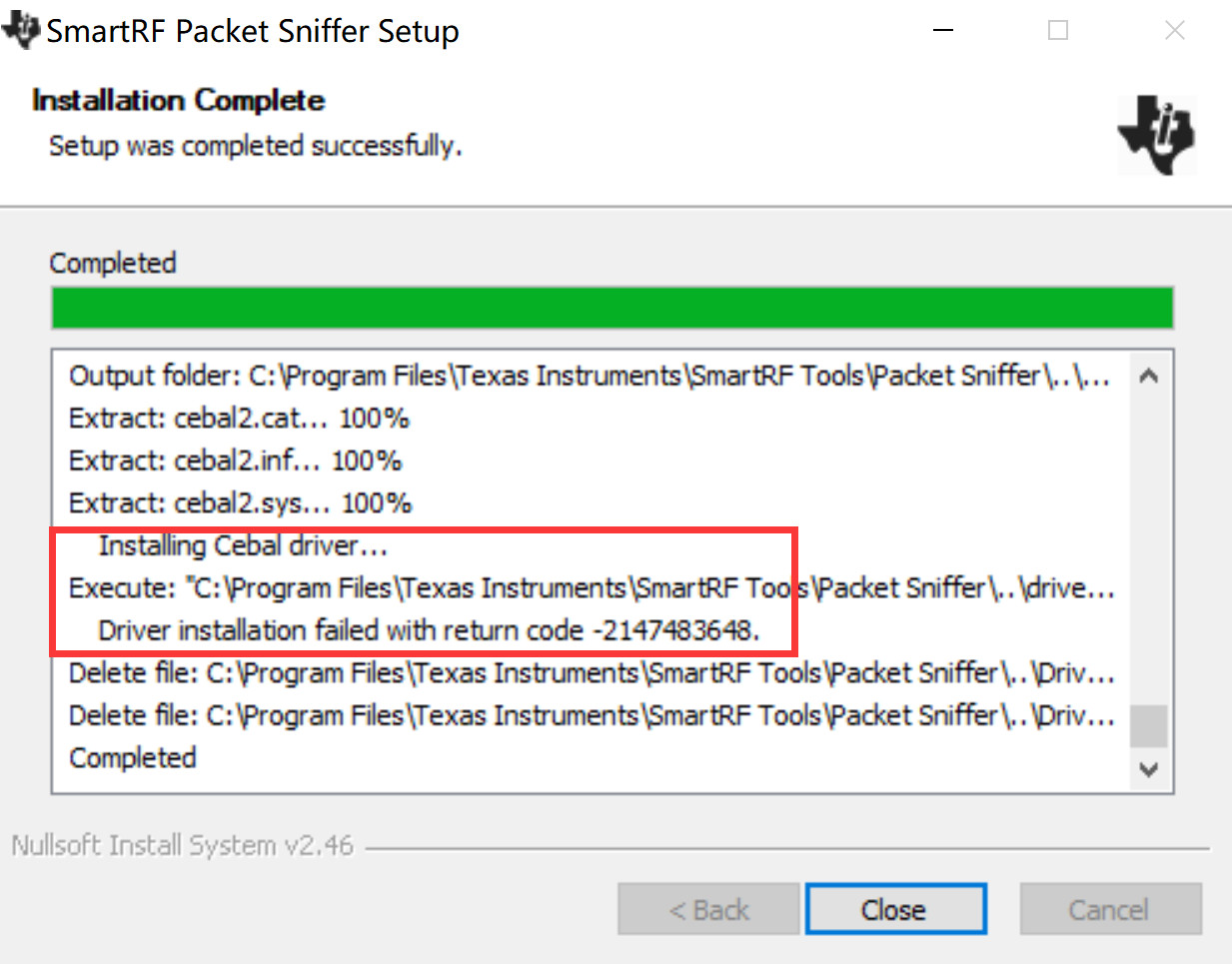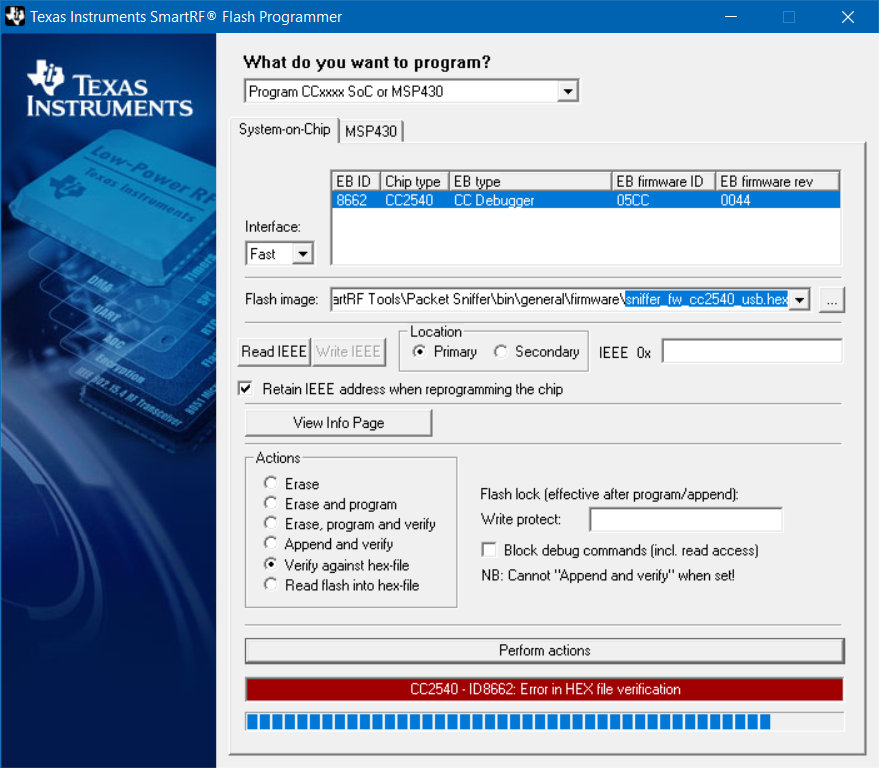| Project CC2540 | |
|---|---|
| Reverse engineering the CC2540 BLE sniffer dongle | |
| Status | Stalled |
| Contact | bertrik |
| Last Update | 2018-05-13 |
- 3Analysis
- 4Protocol
- 4.2Reading BLE frames
The CC2540 USB Dongle is a complete example of how to use the USB enabled Bluetooth Low Energy (BLE) Wireless MCU. The reference design can be used to enable Bluetooth Smart and Internet of Things applications on any system that contains a USB host. The CC2540 USB Evaluation Module Kit contains one CC2540 Bluetooth low energy USB Dongle. The dongle can be used to enable Bluetooth low energy on your PC. It can also be used as a packet sniffer for analyzing the BLE protocol and for software and system level debugging (use the free tool SmartRF Packet Sniffer ). SERVICE = 'TI USB CDC Driver'. DESCCC2538 = 'TI CC2538 USB CDC Serial Port' DESCCC2540 = 'TI CC2540 USB CDC Serial Port' DESCCC2544 = 'TI CC2544 USB CDC Serial. It also, on my Windows 8 laptop, causes my USB keyboard to 'lose' some keystrokes. I sniffed some of the Bluetooth traffic using a TI CC2540 dongle and they have a proprietary protocol on top of.
Status
At this point (2017-05-09), the status is:
- it is pretty clear which commands the default sniffer firmware understands
- I wrote a little test program to dump raw BLE frames
- there is no plugin for WireShark yet
Introduction
This page is about the CC2540 bluetooth low-energy sniffer dongle and getting it to work with Linux.A nice end result could be that it becomes possible to sniff directly in WireShark with this dongle.
I have such a 'WeBee' dongle that can be found for about E15,- on websites like Aliexpress.
It's supposedly a CC2540 (or compatible) dongle, the USB id is 0451:16b3.
Interesting links:
Analysis
USB descriptor
When plugging this stick into a Linux machine, you can see it uses only one bulk endpoint.
Reading the identification from the stick with the 0xC0 command, results in the following 8-byte response
You can recognise the 2540 type number in there.
USB logs from Windows
This USB device does actually work with Windows:
I've captured a log of the communication over USB while the BLE is capturing bluetooth traffic from some iBeacon, using USB pcap.
In the logs, I cannot see any firmware blobs being downloaded to the stick.Probably the stick comes with a pre-loaded firmware of itself to do the BLE sniffing.
The USB control transfer request codes seem to match up with the code in https://github.com/christianpanton/ccsniffer/blob/master/ccsniffer.py
- 0xC0, GET_IDENT: returns some kind of identifier
- 0xC5, SET_POWER
- 0xC6, GET_POWER
- 0xC9, no idea, this appears in my USB logs but I can't find it in the python code
- 0xD0, START
- 0xD1, STOP
- 0xD2, SET CHAN
Protocol
In the windows sniffer software, it seems there are only two things communicated:
- towards the stick: which radio channel to sniff, and some other radio settings
- from the stick: raw sniffed BLE frames
Configuring the radio
This appears to be done using USB control transfers.
Cc2540 Hid
The following requests are sent:
| Request type | Request | Value | Index | Data | Description |
|---|---|---|---|---|---|
| 0x40 | 0xC5 | 0 | 4 | - | Set power |
| 0xC0 | 0xC6 | 0 | 0 | 0x00 | Get power |
| 0xC0 | 0xC6 | 0 | 0 | 0x04 | Get power |
| 0x40 | 0xC9 | 0 | 0 | - | ??? |
| 0x40 | 0xD2 | 0 | 0 | 0x27 | Set channel |
| 0x40 | 0xD2 | 0 | 1 | 0x00 | Set channel |
| 0x40 | 0xD0 | 0 | 0 | - | Start capture |
Request type 0x40 is a vendor-specific device request from host-to-device.Request type 0xC0 is a vendor-specific device request from device-to-host.
Reading BLE frames
This appears to be done using USB bulk input transfers.
I can see a lot of similarities between the USB log and the BLE sniffer log.

Each frame starts with a byte indicating the type of frame, following by two bytes indicating the length of the rest of the frame (encoded as little endian).
data frames
The bulk USB data starts off with two bytes indicating the length of the rest of the data.
In the example image on the right:
- 00: 0 means this is a data frame
- 31 00: length of rest of frame encoded in little endian = 49 bytes decimal
- 39 04 29 54: part of the time stamp
- 2c d6 be ..: data frame contents
unknown frames (tick or 'alive'?)
The stick also returns 4-byte frames, alternating between
and
Interpretation:

- 01: 1 means this is a frame of type 1
- 01 00: length of the rest of the frame encoded in little endian = 1 byte
- 40 or C0: unknown data byte
Software
Preliminary code can be found athttps://github.com/bertrik/cc2540
It connects to the dongle and dumps raw USB packets to stdout.
This software requires libusb-1.0-dev

NOTICE: The Processors Wiki will End-of-Life on January 15, 2021. It is recommended to download any files or other content you may need that are hosted on processors.wiki.ti.com. The site is now set to read only.
Bluetooth Low Energy Wiki Main Page
This page describes some common configurations when using a CC254x in combination with an external MCU.
Overview[edit]
| Name | Description | Advantages | Disadvantages |
|---|---|---|---|
| Network Processor |
|
|
|
| Network Processor GATT_DB_OFF_CHIP |
|
|
|
| Network Processor Custom |
|
|
|
| Stand Alone App with Serial Interface |
|
|
|
Network Processor[edit]
The HostTestRelease project (included with standard BLE SDK) is the standard BLE Network Processor application. It can be loaded on the CC2540 or CC2541, with the any of the following used as a network processor interface:
1. UART
2. SPI
3. USB CDC virtual UART (CC2540 only)
More information on the HostTestRelease project can be found in the CC254x BLE Software Developer's Guide (http://www.ti.com/lit/pdf/swru271). An overview of the HCI command protocol can be found in the TI BLE Vendor Specific HCI Guide, which is linked from the Windows Start Menu after you have installed the SDK.
For applications which only act as a GATT client and do not need to act as a GATT server, this is an ideal choice.
Network Processor GATT_DB_OFF_CHIP[edit]
The HostTestRelease project has an option that can be enabled by including the preprocessor define 'GATT_DB_OFF_CHIP' to the project configuration (under compiler settings). By adding this define, the network processor will be built such that any GATT services are maintained by the external MCU. This includes handling of all peer GATT requests to read, write, and discover services and characteristics.
This option provides for maximum flexibility of the GATT server by the MCU; however the code required on the external MCU is fairly complex.
More information on this type of setup can be found here: http://processors.wiki.ti.com/index.php/LPRF_BLE_NPGATT
Network Processor Custom[edit]
Rather than using GATT_DB_OFF_CHIP, another possibility is to manually add your GATT profiles to the HostTestRelease project, and rebuild the project with the services integrated into the network processor. This reduces the complexity of the external MCU code; however it requires the ability to add custom commands to the network processor in order to allow the external MCU to manage the data in the GATT services.
More information on this type of setup can be found here: http://processors.wiki.ti.com/index.php/BLE_HostTest_Add_Cmds
Stand Alone App with Serial Interface[edit]
Instead of using the HostTestRelease network processor project, another option is to take one of the existing single-chip projects included in the BLE SDK (e.g SimpleBLEPeripheral, HeartRate, RunningSensor, etc...) and modify it to include a 'UART bridge' or a 'SPI bridge', giving the external MCU the ability to communicate with the CC254x.
In addition to creating the brige using the HAL UART or HAL SPI drivers, a communication protocol must be established, allowing the external MCU to send commands to the CC254x (e.g. start advertising, send notification, etc...). It also must allow the CC254x to send event to the external MCU when specific actions occur (e.g. connection established, connection terminated, etc...). For many applications this protocol can be very simple and just consist of a few key commands and events.
Driver Ti Cc2540 Usb Cdc Update
More information on this type of setup can be found here: http://processors.wiki.ti.com/index.php/SimpleBLEPeripheral_SerialInterface
Other UART Configurations[edit]
See the following wiki page for all 4 UART configuations: http://processors.wiki.ti.com/index.php/All_4_uart_configs
{{
Please post only comments related to the article CC254X WITH EXT MCU here. | Keystone=
Please post only comments related to the article CC254X WITH EXT MCU here. | C2000=For technical support on the C2000 please post your questions on The C2000 Forum. Please post only comments about the article CC254X WITH EXT MCU here. | DaVinci=For technical support on DaVincoplease post your questions on The DaVinci Forum. Please post only comments about the article CC254X WITH EXT MCU here. | MSP430=For technical support on MSP430 please post your questions on The MSP430 Forum. Please post only comments about the article CC254X WITH EXT MCU here. | OMAP35x=For technical support on OMAP please post your questions on The OMAP Forum. Please post only comments about the article CC254X WITH EXT MCU here. | OMAPL1=For technical support on OMAP please post your questions on The OMAP Forum. Please post only comments about the article CC254X WITH EXT MCU here. | MAVRK=For technical support on MAVRK please post your questions on The MAVRK Toolbox Forum. Please post only comments about the article CC254X WITH EXT MCU here. | For technical support please post your questions at http://e2e.ti.com. Please post only comments about the article CC254X WITH EXT MCU here. }} |
Driver Ti Cc2540 Usb Cdc Driver
| Links | |||
|